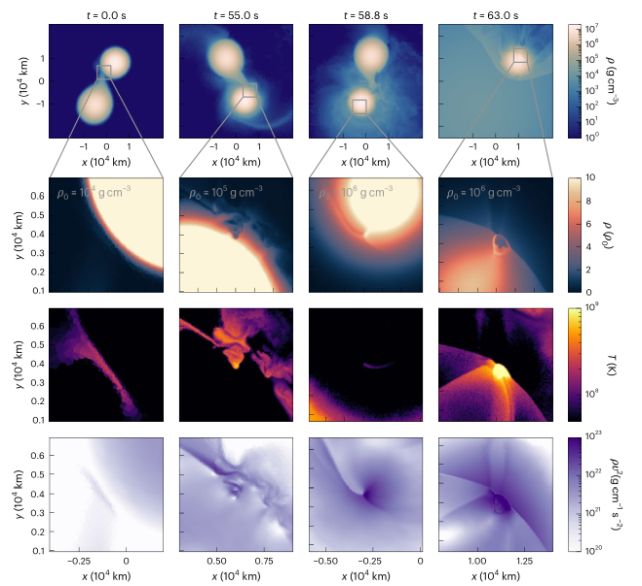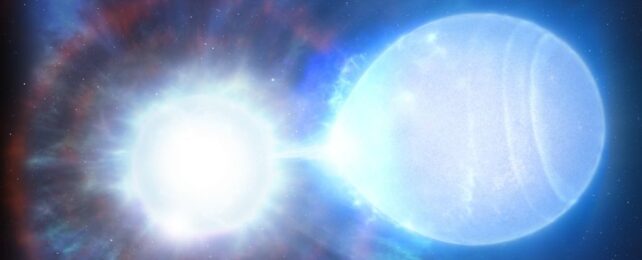Every star that hangs upon the evening firmament will one day die, its lights snuffed and its fires cooling in the dwindling cosmic end times.
We don't always know when, but for a binary star system around 150 light-years from Earth, a precise time of death has now been discovered. Some 23 billion years from now, the two white dwarf stars are destined to smash together.
At least, they would, if not for the fact both will be taken out before this fated merger by a spectacular explosion – a Type Ia supernova, one of the measuring sticks against which we gauge distance in the Universe.
We already knew that white dwarf stars were probably behind Type Ia supernovae, but the finding finally represents confirmation of a theoretical prediction: that the precursor to most of the Type Ia supernovae that light up the sky is not one white dwarf, but two, in a binary system.
"The companion being a second white dwarf is a natural explanation for a large fraction of Type Ias because this type of system is quite numerous in the Milky Way, but we have never found a) a system massive enough that it will certainly explode as a type Ia and b) where this event is similar to the age of the Universe," astrophysicist James Munday of Warwick University in the UK told ScienceAlert.
"With this new discovery, we have found both, and the fact that the system is so close at 150 light-years from Earth (essentially our galactic neighbor) gives the impression that plenty more of these systems should be hiding in plain sight and we have the ability to identify these systems much farther away."
White dwarfs are not living stars as we categorize them. What we colloquially call living stars are those on the main sequence, still fusing hydrogen in the furnaces of their cores. When the hydrogen runs out, the star dies. Outer envelopes are ejected, and the core, no longer supported by the outward pressure of fusion, collapses under gravity.
For the smallest and most numerous of the stars in the Universe, up to around 8 times the mass of the Sun, this core is a white dwarf, an ultradense object with the mass of up to around 1.4 Suns packed into a ball between the sizes of Earth and the Moon. That mass limit is known as the Chandrasekhar limit, the maximum mass a white dwarf can become before it becomes unstable.
The Type Ia supernova that results from a white dwarf breaching its mass limit is a very important one. Such explosions help seed the Universe with the heavy elements sequestered in the core, the products of the fusion the star undertook while it was still on the main sequence. Type Ia supernovae also have a known specific brightness peak, which makes them excellent tools for measuring distances out into the Universe.

Because there are a large number of white dwarf binaries in the Milky Way galaxy, scientists believe they are a prime candidate to explain the high number of Type Ia supernovae out there.
There's just one problem. To produce a Type Ia supernova, the two stars must be close enough for one to tear enough material from its sibling to exceed its Chandrasekhar limit and collapse.
Such systems have been found – but the time they will take to spiral close enough isn't anywhere even close to the current age of the Universe, or 13.8 billion years.
When Munday and his colleagues found the signature of a binary white dwarf in data from the DBL survey, they knew they had found something wonderful.
"Discovering that the two stars are separated by just 1/60th of the Earth-Sun distance, I quickly realized that we had discovered the first double white dwarf binary that will undoubtedly lead to a type Ia supernova on a timescale close to the age of the Universe," he says.
"At last, we as a community can now account for a few percent of the rate of type Ia supernovae across the Milky Way with certainty."
WDJ181058.67+311940.94, as the binary is known, has a combined mass of around 1.56 times the mass of the Sun, and an orbital period of more than 14 hours. As eons pass, the orbits of the two stars will gradually decay, bringing them closer and closer together until – slurp … boom! – off they pop in a Type Ia supernova.
That day is 23 billion years from now; by that time, Earth, and probably humanity, will be long gone, and the Sun will have evolved into a white dwarf itself… so, good news, we're not in any danger from it.
What the discovery does give us is the first concrete evidence that allows us to directly trace Type Ia supernovae to white dwarf binaries, and it shows us what to look for in the hunt for similar systems.
"The whole expectation of double white dwarfs being type Ia supernova progenitors, let alone the majority origin of them, has been completely theoretical and without observational support," Munday told ScienceAlert.
"With this discovery, we found the first double white dwarf that undoubtedly will explode as a type Ia on our galactic doorstep. We can now in fact credit a few percent of the rate of type Ia supernovae in the Milky Way to double white dwarfs, which before was zero."
The research has been published in Nature Astronomy.
